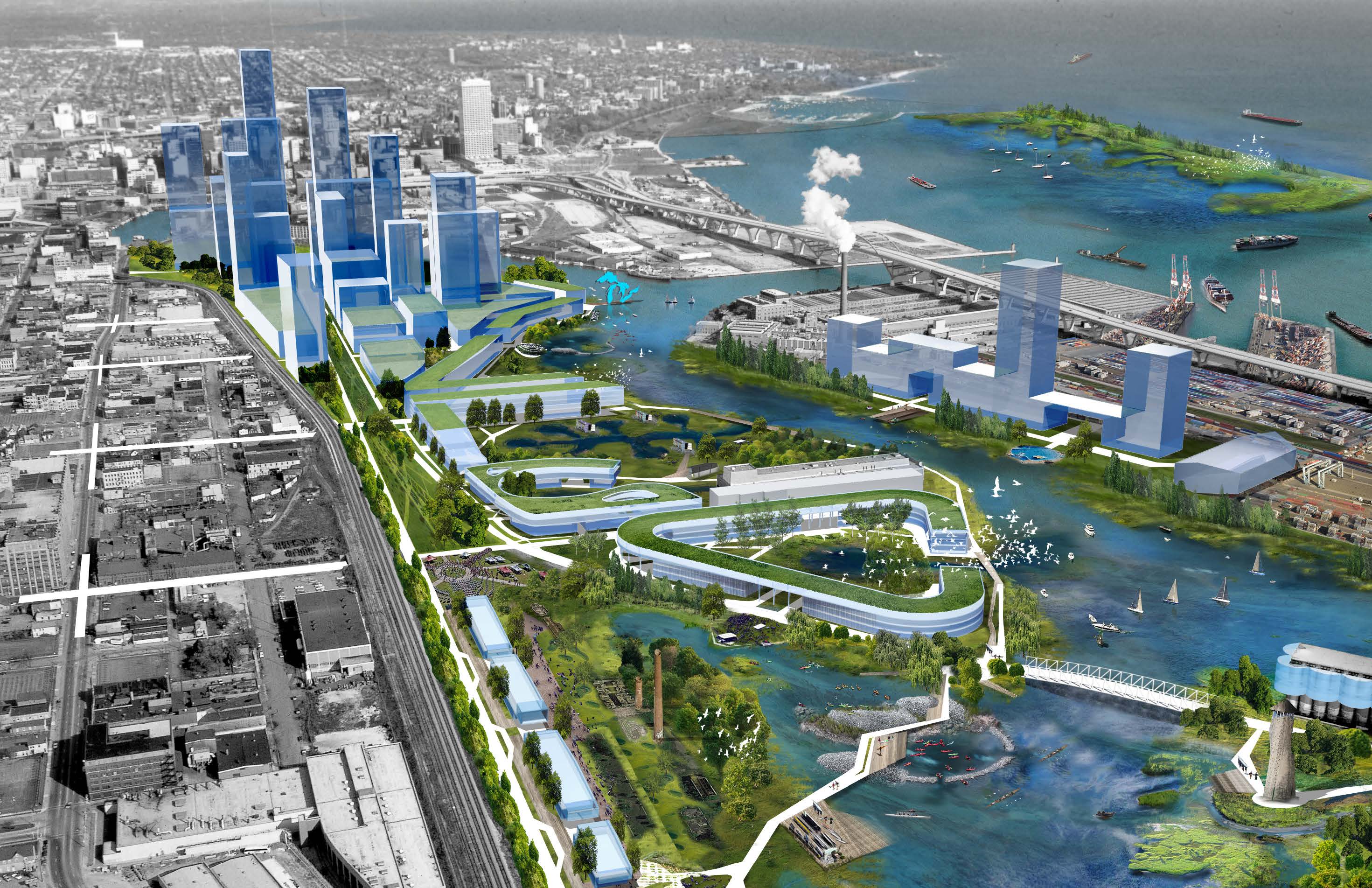OZY Ι Sept. 29, 2016
Past the suburban fringe of Chicago, 60 miles west of Lake Michigan, the seemingly endless rhythm of curving cul-de-sac neighborhoods and strip malls gives way to vast expanses of green — cropland and wild prairie, divided by knots of rail yards where semitrailers wait to pick up cargo. Angular buildings are topped with green roofs, and cantilevered over the tracks are pedestrian-scale eco-villages: apartments, houses, schools and shops mixed in with the blur of shipping activity. Separated by an embankment, bison graze next to one of the continent’s largest inland freight rail hubs … and your kitchen.
Welcome to the Chicago exurbs, circa 2100. These are your neighbors, including the rail yard.
“[The bison are] not just something that you drive out to see once a year,” says Conor O’Shea, a landscape architecture professor at the University of Illinois Urbana-Champaign and the designer of this futuristic nature preserve. “It’s something you see outside your front door.” The animals are the centerpiece of an 85-year plan he calls Logistical Ecologies, which tackles sustainable ways to integrate people, infrastructure and nature at the suburban edge of cities, a place usually ignored by designers.
Landscape architects, ecologists and urban planners are all part of an emerging landscape-design movement that repairs polluted industrial sites with animal and human habitats. The approach harnesses what are known as ecosystem services — the benefits that people obtain from nature. In some cases, the payoff consists of natural processes that repair damaged landscapes. One example: wetland plants that filter pollutants out of water. “People think nature is what you get on your two-week vacation,” says Steven Handel, a Rutgers University ecologist, “but we need the value of eco-services where we live and work.”
Long-running economic changes are also driving these mixed-use projects. Postindustrial economies (like ours) have lots of rusting steel mills and rail corridors going to seed, especially in and around cities. After decades of suburbanization, an increasing desire to live and work in city centers means a growing market wants to explore how industry and animals — including human ones — can coexist.
A number of projects already have established wildlife habitats on former industrial sites, like 2,200-acre Fresh Kills Park on Staten Island, once the nation’s largest landfill. In Chicago, the final section of the Chicago Riverwalk project includes reefs for fish habitats in the formerly rancid Main Branch of the Chicago River. A plan by Studio Gang transformed Chicago’s Northerly Island, previously the site of an airport, into a 91-acre park and wildlife preserve.Northerly Island was a trial run for a larger Studio Gang project called Edge Effect, which proposes a massive reorganization of Milwaukee’s lakefront shipping port. Instead of segregating nature and human activity, Gia Biagi, the senior director of urbanism and civic impact at Studio Gang, says designers need to ask, “What are all the different constituencies, and what is the best way for them to work together in thinking about the whole ecology?”
Edge Effect includes an “ecological breakwater” made of construction debris located on the deep-water side of a man-made peninsula called Jones Island, the site of marine and rail terminals. The breakwater protects an estuary where three rivers converge at the lakeshore, turning it into a tranquil wetland for fish, herons and kayakers.
Wetland restoration also is the aim of the Conway Urban Watershed Framework Plan developed by Stephen Luoni, director of the University of Arkansas Community Design Center. Portions of Lake Conway, located on the outskirts of Arkansas’s fastest-growing city, are polluted with fertilizer from agricultural runoff, which causes massive algae blooms. One of Luoni’s solutions for bringing back freshwater mussels, ducks and other species to this formerly idyllic fish-and-game Eden is decidedly mechanized: solar-powered Aquabots that paddle around the lake, vacuuming up excess algae like aquatic Roombas and injecting oxygen-rich air into the water.
Fionn Byrne, a landscape architecture professor at the Harvard Graduate School of Design, focuses his work on the inherent tension in leveraging the natural world to help us tinker with the planet. Byrne’s biggest speculative project is a series of landscapes in northern Alberta’s Athabasca oil sands, one of the largest resource-extraction sites on the planet. Byrne’s Phantom Ecology includes Crane Lake, a tailings pit that became an improbable bird-watching spot when it was accidentally flooded. Byrne wants to highlight the artificiality of the lake by installing shimmering aluminum poles that will act as nesting sites. “Why always try to make things appear natural when they’re not?” he asks. “Why not accept our role as designers of new landscapes?”
Byrne’s provocations bring up a vital point: No matter how many mountain lions roam a capped-and-sealed landfill, there’s no such thing as restoring these places to an idealized state of nature. “Preservation is not the gold standard,” Luoni says. “What you’re putting back may function, but it may not function like it did before.” Though these hybrid landscapes might be healthier and greener places filled with wild creatures, they are just as designed and intentional as the industrial mess that came before them.
